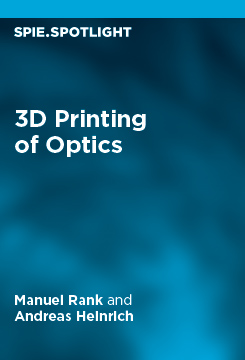|
In comparison to conventional manufacturing technologies, in additive manufacturing, material is deposited rather than removed. Various kinds of methods are used, which are mainly implemented for mechanical applications. Nevertheless, this technology enables a wide variety of new design possibilities for optical components as well. Even some industrial applications of additive manufacturing in the field of optics can be found, as new complex optical components with highly functional integration are possible. Within the field of additive manufacturing of optical components, one example is the high-precision additive manufacturing by means of two-photon polymerization. This process makes it possible to, for example, realize complex-shaped microlenses characterized by a high optical quality and require no rework after the manufacturing process. But the realization of larger optical components or components with very different material properties is a challenge. In addition, a correspondingly high experimental effort or significant financial resources are necessary. Another example is research activities in the field of printing nano-glass particles included in polymer pastes by means of direct ink writing or stereolithography (SLA). After the release of the polymer constituents and sintering, glass optics are created. For many optical applications (especially for illumination tasks), specifications with respect to the optical quality are relaxed or one would like to realize larger complex optical components (see Fig. 1 and a detailed description in Section 6.2). Another common goal is to develop prototypes in a short time which usually involves the production of expensive tools, e.g., injection molding of the optics. This is where conventional "3-D printers" are of interest. With these, it is possible to quickly verify new design ideas for optical components as required for the rapid development of optical systems. In addition, such printing systems can already be purchased with a small budget or be self-made. As a result, a variety of users are interested in the topic. This Spotlight focuses on the 3-D printing of optical components based on the UV curing or inkjet printing of polymers. It shows how a cost-effective 3-D printing system for optics can be built and which materials can be used for printing. In addition, the characteristics of the printed optics and possibilities for reworking the surfaces are demonstrated. Finally, different examples of 3-D printed components are shown to demonstrate the potential of the 3-D printing technology. |
|
|
CITATIONS
Cited by 8 scholarly publications.
3D printing
Printing
Optics manufacturing
Optical components
Additive manufacturing
Polishing
Sensors


